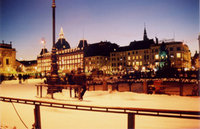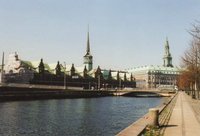Copenhagen
|
|
Copenhagen (Danish: K�benhavn) is the capital and largest city of Denmark. The contemporary Danish name for the city is a corruption of the original designation for the city, "K�bmandshavn," or "Merchants' Harbour" in Danish. The English word for the city is derived from its German name, "Kopenhagen." Copenhagen is home to the national parliament, government, and monarchy, which are all situated in the heart of the city.
| Contents |
History of Copenhagen
- Main article: History of Copenhagen
Copenhagen was founded around year 1000 by Sweyn I Forkbeard and his son Canute the Great (Knud den Store (http://da.wikipedia.org/wiki/Knud_2._den_Store)). It was only a fishing village until the middle of the 12th century when it grew in importance after coming into the possession of the Bishop Absalon, who fortified it in 1167. The excellent harbour encouraged Copenhagen's growth until it became an important centre of commerce (hence its name). It was repeatedly attacked by the Hanseatic League as the Germans took notice. In 1254, it received its charter as a city under Bishop Jakob Erlandsen.
1658-59 it withstood a severe siege by the Swedes under Charles X. In 1801 a British fleet under Lord Nelson fought a major battle, the Battle of Copenhagen, with the Danish navy in Copenhagen harbour. When a British expeditionary force bombarded Copenhagen with rockets in 1807, to prevent Denmark from surrendering its fleet to Napoleon, the city suffered great damage and hundreds of people were killed.
During World War II Copenhagen was occupied by German troops along with the rest of the country from 9th of April 1940 until 4th of May 1945. The city has grown greatly since the war.
Since the summer 2000, the cities of Copenhagen and Malm� have been connected by a toll bridge/tunnel (Oresund Bridge), which allows both rail and road passengers to cross. It was inaugurated in July 2000 by King Carl XVI Gustaf of Sweden and Queen Margrethe II of Denmark. As a result, Copenhagen has become the center of a larger metropolitan area which spans both nations. The construction of the bridge has led to a large number of changes to the public transportation system and the extensive redevelopment of Amager, south of the main city. However, the bridge has not been as widely used as was originally hoped, likely due to the high tolls, slowing the planned integration of the region. Another hindrance to the integration of the region is the lack of a commonly acceptable currency throughout the area. It is still difficult to pay with either nation's currency in the other country.
Geography
Copenhagen is located on the eastern shore of the island of Zealand (Sj�lland) and partly on the island of Amager. Copenhagen faces the �resund, the strait of water that separates Denmark from Sweden, and that connects the North Sea with the Baltic Sea. On the Swedish side of the sound directly across from Copenhagen lie the towns of Malm� and Landskrona.
1,116,979 people live in metropolitan Copenhagen (Stork�benhavn). Of these 502,204 live in the Municipality of Copenhagen, 91,721 in the Municipality of Frederiksberg, 68,704 in the Municipality of Gentofte and another 454,350 in other nearby municipalities. An even larger metropolitan region is known as Hovedstadsregionen (translated, "the capital region"), which consists of the municipalities of Copenhagen and Frederiksberg, and the counties of Copenhagen, Frederiksborg and Roskilde. The population of Hovedstadsregionen is 1,823,109. Copenhagen is also a part of the �resund region, which consists of Eastern Zealand and Western Scania (in Sweden), and has a population of 2.8 million people.
Culture
Copenhagen has by Danish newspapers been rated one of the best cities in the world in which to live, though it also has a high cost of living.
Str�get, a pedestrian shopping street in central Copenhagen was inaugurated in 1961. Copenhagen's extensive pedestrian network has been developed over the last 40 years through the work of one man, the Danish architect and professor Jan Gehl.
Cuisine
Copenhagen offers a great variety of fine restaurants and modest eateries with open sandwiches (called "sm�rrebr�d") as the most known dish. Also, Copenhagen is known for the great tasting hotdog stands found throughout the city. Lately, immigration from the Middle East and North Africa has made dishes like kebab and falafel as popular as more traditional Scandinavian fast foods.
Transportation
Copenhagen has a public transportation system, consisting of commuter trains (called "S-Trains" (S-tog)), buses, and a new but still small metro. The S-trains form the basis of the transportation network, stretching to most areas of metropolitan Copenhagen, with their main hub at Copenhagen Central Station (K�benhavn H). Some regional trains supplement the S-train services with lines extending further such as to the Copenhagen Airport, Elsinore, and Malm�. The entire system is governed by the same overall authority and tickets are transferable from one mode to another. The region is divided up into 99 zones which govern the cost of a ticket. Travelling through 2 zones is less expensive than 3, 4, or more zones. A trip of 7 or more zones costs a base rate. Ticket prices are high and have increased substantially in recent years leading to a decrease in passenger numbers. In fact the percentage of trips made on public transportation in Copenhagen is quite low by northern European standards.
An extensive road system is also in place for private automobiles, and the city's bicycle paths are extensive and well-used. The city provides public bicycles which can be found throughout the downtown area and used with a returnable deposit of 20 kroner. Bicycle paths are often separated from the main automobile lanes and have their own signal systems.
Places of Notes in or Near Copenhagen
Img_0050_edited.jpg
- Amalienborg Palace
- Arken Museum of Modern Art
- B�rsen The Stock Exchange
- Bakken
- Christiania
- Christiansborg
- Copenhagen Zoo
- Danish National Gallery
- The Deer Park
- Frederiksborg Palace in Hiller�d
- Gefion fountain
- Kastellet
- Kongens Have
- Kronborg Castle - Hamlet's castle in Elsinore (Helsing�r)
- The Little Mermaid
- La Fontaine
- Louisiana Museum of Modern Art
- National Museum
- Ny Carlsberg Glyptotek
- Nyhavn
- Rosenborg Castle
- Str�get
- Tivoli Gardens
Famous Copenhageners
- Karen Blixen a.k.a. Isak Dinesen
- Niels Bohr
- Aage Bohr
- Tycho Brahe
- Frederik Grundtvig
- Ludvig Holberg
- Iben Hjejle
- Tove Ditlevsen



